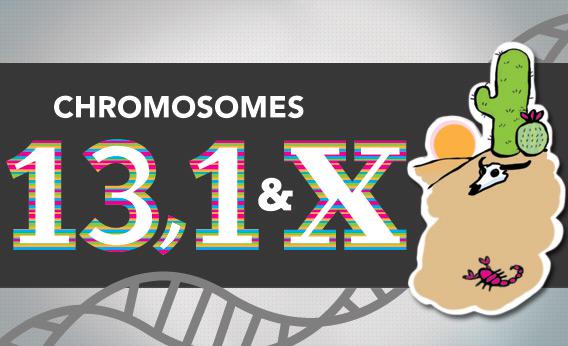Geneticists in the early 1900s believed that nature—in an effort to avoid wasting precious space within chromosomes—would pack as many genes into each chromosome as possible. So when these geneticists started mapping genes—that is, determining where exactly genes sat along the length of chromosomes—they assumed that genes must almost bump up against each other in a tight archipelago, like Alaska’s Aleutian Islands. Not so. In reality, protein-producing DNA is exceedingly rare, scattered like the Micronesian islands across vast chromosomal Pacific Oceans.
The most barren chromosome is chromosome 13. Its stubby short arm contains almost no genes to speak of, and (to switch geographic metaphors) even its long arm contains huge deserts with as few as three genes per million letters of DNA. If this stretch of chromosome 13 were a typical hardcover book, that average level of scarcity would correspond to just 4,500 letters of useful information—roughly as many letters as in this post—sprinkled in among 400 pages of gibberish.
So what does all that extra DNA do? Scientists long assumed it did nothing, and dismissed it as “junk DNA.” The name has haunted them as an embarrassment ever since. Junk DNA actually contains many critical stretches that turn genes on and off, or otherwise regulate them—the “junk” can manage genes. To take one example, chimpanzees and other primates have short, firm, keratin-rich bumps (called spines) studding their penises. The X chromosome contains the DNA to build these spines. Humans lack the spines, however, because sometime in the past few million years we lost 60,000 letters of regulatory DNA on the X—DNA that would otherwise coax certain genes (which we still have) into making them. The loss decreases male sensation during sex and thereby prolongs copulation, which some scientists suspect helps humans pair-bond and stay monogamous.
All that said, large swaths of human DNA do look expendable. Before the Human Genome Project, most scientists assumed, based on our complex brains and behaviors, that humans must have around 100,000 genes; some estimates went as high as 150,000. To make the debate interesting, some geneticists drinking at a bar one night in 2000 set up a “gene sweepstakes” with a $1,200 pot for whoever guessed closest to the correct number. More than 150 scientists entered. Usually the guesses in a penny-counting contest like this cluster in a bell curve around the correct answer. Not here: As HGP scientists rifled through the genome, the estimate dropped to 90,000, then 70,000, then 50,000—and kept sinking. The lowest guess (25,947) eventually won the sweepstakes, and most current estimates put the number of human genes below even that.
No one expected so much noncoding DNA, but its existence may hold clues about what traits make humans unique—perhaps it’s less our sheer number of genes, and more the way we regulate and splice DNA. But the really unexpected thing about all that empty DNA was that it made the name Human Genome Project seem like something of a misnomer. In all, the project showed that protein-coding DNA makes up less than 2 percent of our genome. At the same time, it showed that 8 percent of our genome consists of old virus DNA that got inserted long ago and never got cleaned out. (Some viruses, like HIV, have special enzymes that insert viral DNA into human chromosomes; this insertion tricks our cells into making viral proteins.) So by that measure at least, we’re four times more virus than human. One pioneer in studying viral DNA, Robin Weiss, put this relationship in stark terms: “If Charles Darwin reappeared today,” Weiss mused, “he might be surprised to learn that humans are descended from viruses as well as from apes.”
Most of that viral DNA has broken down and doesn’t do anything—it’s the genetic equivalent of a ‘75 Pontiac sitting in the yard on cinder blocks. One exception occurs on chromosome 1. Some DNA on this chromosome has long produced an enzyme in our digestive tracts, amylase, that breaks down complex starches into simpler sugars. But viruses seem to have inserted, wholly by accident, a genetic on/off switch into chromosome 1 that floods our saliva with amylase, too. As a result, starches taste slightly sweet inside our mouths as we chew. We almost certainly wouldn’t have such a starch-tooth for breads, pastas, and grains without that switch.
Even more spectacularly, as I explain in The Violinist’s Thumb, the placenta—one of the more important innovations in the mammalian line—seems to have plagiarized some key DNA from viruses. Some scientists also argue that viruses and other virus-like DNA may have added variety to the genes that form and run our brains. This variety included mutations, which usually cause short-term havoc. But in the long run mutational variety is the raw material of evolution, and if this theory is correct, then these parasites may have goosed our brains and made them function better. What’s more, any microbes responsible for evolutionary boosts likely got passed around, among other ways, via sex. Which means that, if microbes were as important in pushing evolution forward as some scientists speculate, something akin to STDs could have contributed, in some small way, to human genius.
